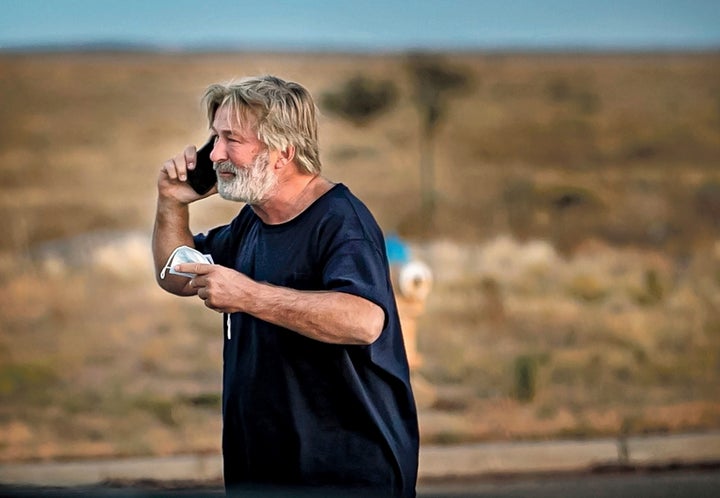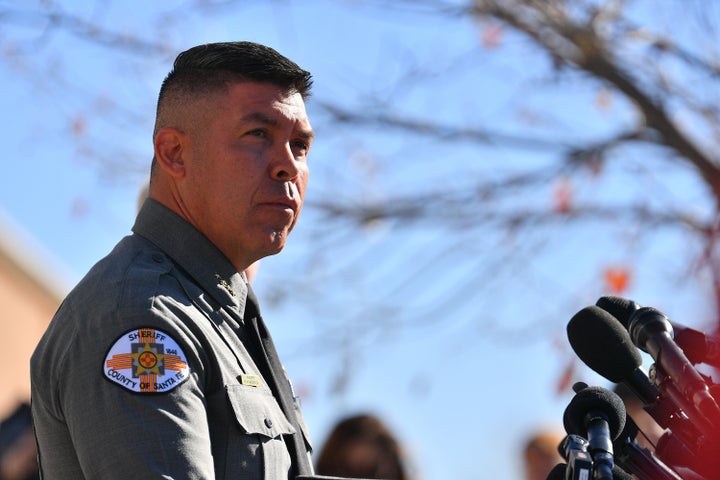
More than a week after the shooting on the “Rust” film set in New Mexico, details continue to trickle out explaining how actor Alec Baldwin wound up with a loaded gun in his hand.
Police have yet to conclude the investigation, but one element has become clear: Several people repeatedly mishandled the firearm that killed director of photography Halyna Hutchins and injured director Joel Souza.
A small set of simple rules dictates how to handle firearms safely: Always know if the gun is loaded. Keep the barrel pointed in a safe direction. Never point a gun at anything you’re not willing to destroy. Know your target and what lies beyond it.
Those rules exist because humans are prone to error, but guns reliably fire when the operator pulls the trigger. With a swipe of his arm, Baldwin broke all four. And the people charged with handling guns on the set broke several more, all but ensuring that the weapon would morph from a prop into a dangerous liability.
“You had to have more than one safety measure fail for that to happen,” Doug McQuarrie, a former NAVY Seal who’s helped bring firearm scenes to life on several film sets, told HuffPost.
If Baldwin were anyone other than an actor, the shooting on the set of “Rust” would be an obvious case of negligence. But he wasn’t alone in mishandling the weapon.
The inexperienced armorer in charge of the weapon, the assistant director who grabbed the gun and shouted “cold,” and crew members who reportedly took it for a round of target shooting all played some part in a long chain of compounding irresponsibility that led to a negligent discharge in an industry that portrays gun battles as a matter of routine ― usually without incident.
HuffPost spoke with firearms experts, including three with wide experience working on film sets, and reviewed public documents to understand what went wrong. While the investigation has yet to conclude and many details remain unknown, all agreed that several overlapping problems led to the fatal shot. And some suspect that Baldwin himself may own a share of the blame for mishandling a loaded weapon during rehearsal.
“The rules are there,” Bill Davis, a former police officer and armorer with two decades of experience, told HuffPost. “You follow them, you won’t have a problem. If you don’t follow them, you will. The safety protocols are only as good as the people observing them.”
Baldwin Should Not Have Handled A Real Gun
The confusion around the shooting revolves partly around the distinction between a gun and a “prop gun.” Prop guns are typically modified to fire only blanks, often through a plugged barrel. Baldwin didn’t fire a “prop gun” in anything but a euphemistic sense. He pulled the trigger on a .45 revolver and it fired a projectile, almost certainly a bullet. It wasn’t just a prop. It was a gun.
That shouldn’t have happened for at least two reasons. First, live rounds ― cartridges that fire a bullet ― aren’t typically allowed on movie sets. But among the 500 rounds confiscated from the set, police found fake cartridges, blanks and live ammo. No one consulted by HuffPost could imagine a scenario where that made sense.
“I was absolutely shocked to hear that there were live rounds,” McQuarrie said. “I’ve never seen that on a set.”

And in the situation Baldwin was handling the revolver, prop masters said he shouldn’t have used a real gun. The filmmakers weren’t shooting a scene at the time. Instead, Baldwin was rehearsing the movement that would eventually make it into the scene, a practice known in the industry as “blocking.”
Blocking rehearsals typically require neither a “hot” gun loaded with blanks nor an unloaded “cold” gun, but a “dummy” gun ― usually made of rubber or plastic and incapable of holding cartridges or firing bullets.
Police recovered three different revolvers from the shooting scene, Santa Fe County Sheriff Adan Mendoza said Wednesday: a fully functioning .45 revolver, a gun with modification to the cylinder likely making it capable of firing only blanks, and a plastic gun.
Live Rounds Shouldn’t Have Made It Into The Gun
Even if there were live rounds on the set, they shouldn’t have made it into the gun. Blanks are easy to tell from live rounds, because no bullet pokes out from the casing.
Film sets don’t appear to have universal standards for loading guns with blanks or demonstrating that they are unloaded. But most agreed that the armorer holds supreme authority of firearms used in movies, followed by other prop masters and technical consultants. That makes the chain of custody simple: Only the armorer or actor touches it.
“I’ve never seen any crew allowed to touch any gun,” McQuarrie said. “Not ever.”
On the set of “Rust,” however, those charged with monitoring the gun that fired the fatal shot left it out in the open. Instead of the armorer securing it, crew members used it to target shoot during off hours, according to news reports.
And assistant director Dave Halls grabbed the gun and handed it to Baldwin, when that job should have fallen to Hannah Gutierrez Reed.
Baldwin Mishandled The Gun
The chain of mishaps ended with Baldwin himself. Despite the assistant director’s call that the gun was “cold” (meaning unloaded), police affidavits indicate it held a single live round in the cylinder.
Prop masters consulted by HuffPost disagree over whether Baldwin should have known. His reliance on the assistant director’s word that the gun was unloaded flies in the face of safe firearms handling, which dictates that the first thing anyone handling a gun should do is check whether it’s loaded, according to Mike Cargill, a firearms instructor and owner of Central Texas Gun Works in Austin.
“This is definitely negligent,” Cargill told HuffPost. “In the end, if you’re the person holding the firearm, you’re the person who’s going to be held responsible.”

But Hollywood appears to lack a universal standard dictating whether the actors should understand the status of the guns they handle. One said actors, by design, should rely on the expertise of the armorer. Checking the magazine or inspecting the cylinder runs the risk of disturbing the armorer’s work, introducing an unwelcome element of uncertainty.
“I don’t see any way, shape or form to blame Alec Baldwin,” McQuarrie said. “He’s in another world, acting. And all the other variables are being controlled by everybody else.”
But at least in New York, according to prop master Lucien Charles, it’s standard for armorers to load firearms that will contain blanks or demonstrate that a gun is unloaded in front of at least one other person, usually the assistant director, and often with the actor who will handle the gun present.
“Obviously, Mr. Baldwin should have done that with the armorer, with the assistant director standing there,” Charles said. “As long as everyone has an eye on it, they can make sure it’s safe. And the AD will know it’s a cold gun. It’s unfortunate someone lost their life over someone not doing a safety check.”
And even if the gun was unloaded, Baldwin appeared to handle it irresponsibly, some said. No one should point a gun, even if unloaded, at another person.
“The cardinal rule that he broke is he pointed a the gun at a human,” Davis said. “He’s handled guns in a lot of movies. He should know better.”
It’s unclear whether Baldwin, Gutierrez Reed, Halls or anyone else will face criminal charges in the “Rust” shooting. Prosecutors are leaving “all options on the table,” Santa Fe District Attorney Mary Carmack-Altwies said this week. The 1993 shooting that killed actor Brandon Lee on the set of the film “The Crow,” the most similar case in an industry where firearm deaths are rare, did not result in criminal charges.
Both the Lee and Hutchins shootings appear unintentional, which helps determine prosecutors’ understanding.
But the strict rules governing firearm safety leave virtually no room to pardon an unintentional shot as an accident. A gun fires when a human pulls the trigger, the logic goes, making someone responsible for 100% of the rounds that fly out of the barrel.
“It’s culpable negligence,” Davis said. “There’s nothing accidental about it.”
